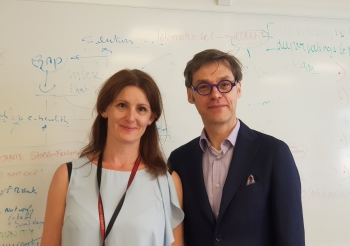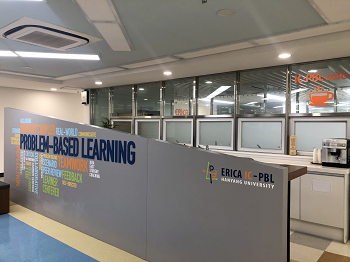PBL at work and its prospects
To investigate how students responded to problem-based learning (PBL), Ewha Voice took a journey to Gotland and Uppsala University to discover PBL in action. While brainstorming solutions to cases, students were freely invited to share their opinions in the entire PBL process. Professors taking on the role as supervisors, PBL showed a completely different classroom environment. Through continuous discussions, students internalized the critical values of coming up with rational solutions to real-life problems. Discovering PBL at work and its prospects was the main goal of investigating Swedish universities hoping to set it as an example for a more active education environment in Korea and Sweden.
Health Innovation and Entrepreneurship in Practice – Cluster and Pitch

To fully understand the real atmosphere of PBL on campus, Ewha Voice visited “Health Innovation and Entrepreneurship in Practice 2019,” a summer course at Uppsala University.
The course was run by Lina Sors Emilsson, a project manager at Uppsala University, and Mark Govers, an associate professor in the Department of Health Services Research at Maastricht University. As this course was funded by EIT Health, a European association that works with education, innovation, and business, Govers joined the course as a partner from EIT Health.
“As investment in student’s health, nutrition, and education is becoming more crucial for national development and sustainability, we decided to organize this course for the first time this year,” Emilsson commented.
The class started with Govers’s explanation on how to generate practical and achievable solutions. However, he only gave an abstract and broad guideline.
In the course, a total of eight students were asked to work in pairs or groups to come up with solutions for health challenges. They first identified the challenges based on the case provided in the beginning of the course, and tried to plan out detailed solutions.
According to the course syllabus, the given case was “developing a collaborating product prototype that will empower the health and wellbeing of university students in Europe.” For instance, one of the identified challenges was how to offer more education opportunities to university students regarding health.
“This tactic allows students to learn how to put their skills together in innovative projects by themselves,” Govers replied when asked why he gave minimum guidelines. “In PBL, I’m not supposed to give them answers. It’s a self-going process, I want them to drive this class.”
Following his explanation, students had about fifteen minutes to discuss feasible solutions in groups. Govers went up to each group and gave them feedback, only to prevent them from heading in the completely wrong direction.
One interesting part about the group discussion was that students used memos and sticky notes to cluster everyone’s ideas. After writing down their notes, they posted it on one side of the classroom wall to share it with everyone. Written on one of the shared memos was an idea on how to cover costs and find major revenue streams regarding their solutions.
After the discussion, each group was asked to present and share their plans in front of the class for two minutes, which Govers and Emilsson called “pitch.”
According to Emilsson, pitch is delivering opinions verbally without using other sub-materials. Throughout the class, students were continuously asked to pitch their thoughts.
“It’s never enough to emphasize the importance of pitching,” Emilsson commented. “Without PowerPoint or fancy pictures to help them, students learn how to communicate with people. Delivering a speech has become very important these days.”
“I believe students can build their own bubble of knowledge through the negotiation and discussion process in PBL,” Emilsson stated. “Pitch is just one way of doing so. This kind of PBL’s characteristic allows students to take on innovative skills and apply knowledge to real-life cases.”
Student Interviews from Health Innovation and Entrepreneurship in Practice

Ketija Danovska
Masters’ student in Public Health at Stockholm University
“It was great to explore how it would be like to work on a real product. This is something you don’t normally experience in university classes, making it a great advantage of a PBL style class.”
Karima Tice
Studying business with a medical background
“Basically, I like everything about this course. Integrative learning and two minutes pitch without PowerPoint are what I like the most. I plan to take similar PBL style courses in the future.”
Love Chrisson
Studied medicine at Uppsala University
“Many workshops are held in this class and I find it rewarding to discuss different aspects of health-related issues. This PBL style class is new to me, but I still find it inspiring.”

Innovation Game – Open and Vibrant
Innovation Game is a summer course held in Gotland Campus by Uppsala University and EIT Health. According to the course syllabus, Gotland residents live a sedentary lifestyle with low levels of physical activity. They also tend to show a lack of interest in higher education. Thus, Innovation Game partially adopted the PBL method to design more serious games for health challenges in Region Gotland.
Ewha Voice observed how students reacted to the given challenges on the first day.
Total of 22 students joined the class, with its overall ambience being very open and vibrant. They were also free to enjoy food and coffee set up by teachers at the back of the classroom, which created a relaxed atmosphere.
After students were arranged in groups, they were introduced to the challenges that they were going to work with for the next three weeks.
Some of the given challenges were; encouraging physical activity with the use of a sensor and gamification and providing a healthier lifestyle for people with chronic health conditions by using an eHealth application.
There were also many collaborators who joined the course, including invited speakers like Adam Mayes, a game design educator at Uppsala Gotland, and Kristaps Krafte, founder and CEO of Vigo. Vigo is a digital therapeutics service for stroke rehabilitation. Students were always given opportunities to share details about their projects with the invited speakers, who had a handful of experiences on eHealth.
“It is about learning how to use game principles to solve health challenges and using interdisciplinary teams in innovative processes,” explained Erik Olsson, the course organizer.
“Our goal for this course is to develop serious games that can actually help people in Gotland to have a better lifestyle.”
Erik Olsson is a researcher and an associate professor in Clinical Psychology in Health Care at Uppsala University. Although Innovation Game is not his specialty, which is cardiovascular psychology, he was in a planning group four years ago where the school then asked him to be the course leader.
“Students will examine problems defined by society,” Olsson commented. “Along with representatives of healthcare, they will create innovative solutions for a healthier lifestyle.”
He remarked that he partially adopted the PBL tactic in this course to connect many organizations.
As the course required a big collaboration with the game department and other European universities, Olsson explained it would have been much more difficult to run the course in other teaching methods.
“Solving given challenges is like role-playing,” Olsson concluded. “Students can imagine themselves working in an actual game studio. Like a role-play, they can fictionally solve the problems. PBL suits this course very well in that sense as it allows the class to be more fun and engaging.”
Prospects of PBL
The current problem-based learning (PBL) has a small spectrum in the majors that utilize this model. However, many educational institutions are beginning to find ways to apply PBL in all areas.
The Head of Department of Valand Academy University of Gothenburg, Troels Degn Johansson, shared prospects of PBL in Sweden. Johansson conducted research and practiced PBL at Valand Academy, the school for film, photography, literary composition, and fine art.
“PBL is already widely adopted in Scandinavian countries, but there is always room for improvement,” Johansson said. “Many think it is hard to apply PBL because arts and design is practical. But, as an artist, you need to also consider ethics.”
Johansson mentioned that in an art lecture, ethics is emphasized because as an artist, one should always think of ways to involve themselves in the community through their artworks.
“Artists have the desire to get their hands dirty and present all sorts of pieces, but they also want people to like their artwork,” Johansson added.
“Through PBL in the art sector, students are taught to create art considering the ethics in society. To do so, we present current issues to the class and ask them to think about it while working.”
PBL is a lifelong concept where as long as detailed research is conducted, it can be applied anywhere. Johansson hopes to see more PBL in action all around the world because such model encourages students to work harder and prepares them for the professional world.

PBL strikes in Korea: IC-PBL
Although PBL is not well-known in Korea, Hanyang University (HU) has utilized it since 2016. Hanyang University ERICA campus was the first in the country to implement industry-coupled problem-based learning (IC-PBL), a learner-centered educational model where students solve context-rich problems occurring in real-life fields, coupled with industry, society, and university.
“IC-PBL is a specialized form of PBL where we work hand-in-hand with real companies,” said Park Ki-soo, the director of ERICA IC-PBL Center. “It has two key factors: whether the problems is provided by industries or institutions; and whether the field provides feedback on the students’ problem-solving process.”
Park further explained four different types of IC-PBL - Merge, Evaluate, Create, and Anchor. “Merge” is in-class application from problems provided by real-life fields along with evaluation and feedback on the problem-solving process, and “evaluate” is when the instructor designs the problems and evaluation and feedback are provided by the fields. “Anchor” is when problems are directly provided or requested by an industry or institution, but there is no intervention by them as feedback is given within class participants. “Create” is the instructor designing the problems with feedback and evaluation within the class.
According to Park, HU started with a trial run with four classes where the overall feedback were positive. Students were given a chance to give pitches to companies, while professors could see that students were more engaged in class. IC-PBL grew steadily with 246 major courses being led in this model this semester.
“It is common to see PBL used in the medicine field,” Park added. “However, we have applied this to all majors including the liberal arts departments. Now, for students who entered university in 2017 and onwards, taking at least four IC-PBL classes has become a graduation requirement.”
Park further commented that HU partnered with several companies like Pulmuone, Adidas Korea, and Disney, to receive cases and find solutions to them through the ideas presented by the students. The students once created an advertisement plan for an upcoming Disney movie in which they gave a pitch to the Disney headquarters in the U.S. through video call.
Campus layout was also emphasized by Park where in the ERICA campus, the entire school was suited for IC-PBL. There were rooms called “PBL classrooms” with movable furniture, whiteboards on all four walls, and many open spaces throughout the campus to encourage teamwork and discussions.
Setting ERICA IC-PBL as an example for universities in Korea, Park concluded with a positive note stating that the future is bright for PBL.
“All we need is the school’s willingness to develop the hardware of the education system. Modifying the school’s education model will naturally change the atmosphere of the campus. I just want to say to all educators, give it a try. If you try, you will see the benefits. You will see the glitter in the students’ eyes once they enter the classroom, eager to learn.”

